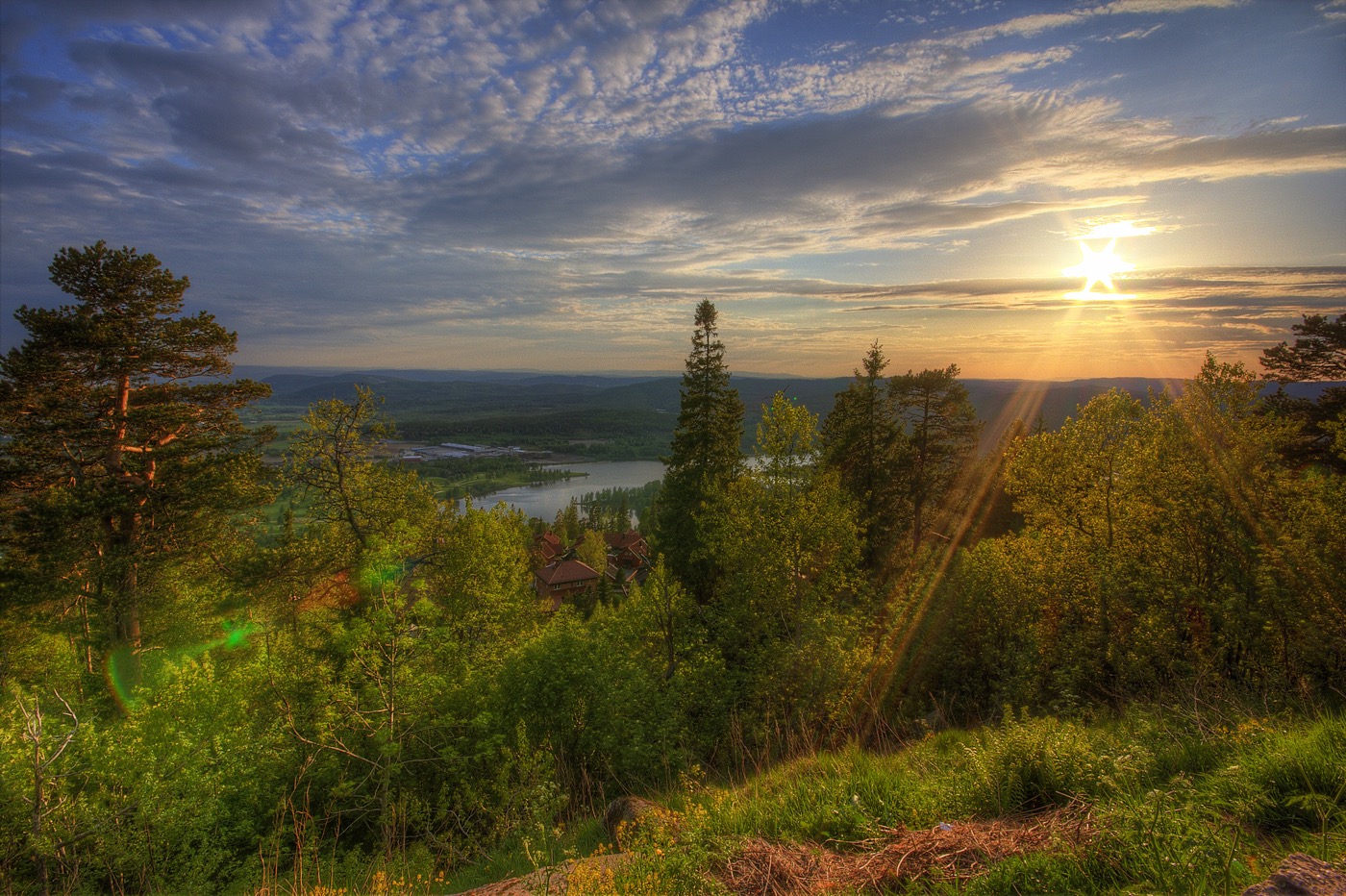Getting from Point A to Point B on a road trip through Norway may end up taking much more time than you expected. Why? Because you’ll want to pull the car over so many times to take pictures and gawk at the spectacular natural beauty lurking around every bend and curve. Look, a waterfall! Wow, a double waterfall! Check out that fjord! Wow, Those mountains go on forever. And while much of this Scandinavian country is one big photo opportunity, the areas that are particularly noteworthy have been designated as National Tourist Routes, 18 in all, and I would be driving a few of them. The first was the 21 mile long Atlantic Road, which begins after about an hour’s drive from the town of Kristiansund on the west coast. It zigzags over small islands connected by a series of low bridges jutting into the sea (back in the day, boats were the only means of transportation for the residents of these isolated communities). Along the way there’s a turnoff for the charming island of Haholmen, where I would overnight.
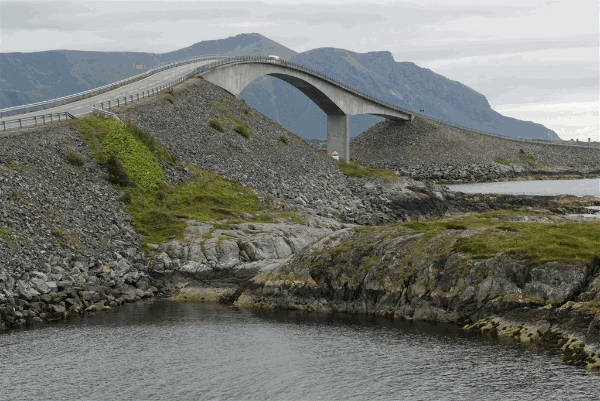
I parked the car and boarded a replica of a Viking ship for the ten minute ride to the island, a 13 acre former fishing village and trading post where many of the rustic barn-red and mustard yellow cottages for guests date from the 18th century (with extremely reasonable rates, refreshing in a country so expensive). Here one simply enjoys the solitude, taking long windswept walks along trails leading down to the water. You can also learn about Ragnar Thorseth, a famous Norwegian adventurer who owned the island until the late 80’s, in a small museum dedicated to him and his exploits. He is well-known for sailing a replica of a 1,000 year old Viking ship, the Saga Siglar, around the world. It was destroyed towards the end of his journey and some of the salvaged pieces have been reassembled and put on display. After an aquavit and a delicious dinner of fresh cod in the rustic wood-paneled bar decorated with old boating and fishing equipment, I drifted off in my cottage.
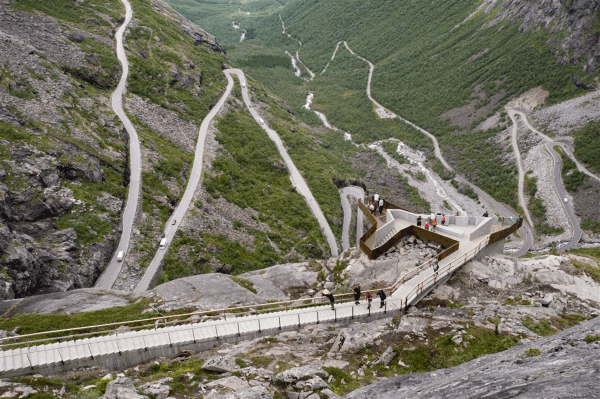
The next National Tourist Route to discover was Trollstigen or Troll’s Ladder, a drive up a mountain road with 11 hair raising hairpin turns. At the top you’ll park and walk a bit to a lookout point with a panoramic view of the valley, jutting straight out over the mountain – it’s not for the faint of heart. From there a twenty-minute drive put me at a unique retreat called Juvet Landscape Hotel, designed by Norwegian architects Jensen & Skodvin. Consisting of seven minimalist rectangular cabins with one glass wall allowing for nature to take center stage, it seemed as if I could reach out and touch the rushing waters of the Valldola River. Guests here dine communally in the more traditional wood-paneled main house and included during my stay an English couple on their honeymoon and a retired Swedish couple.
The final Tourist Route of my road trip, the 64-mile Sognefjellet, showed me some of Norway’s wildest mountain scenery as I passed jagged snowcapped peaks, Sognefjord, the longest fjord in the country and Jostedalsbreen, the mainland’s largest glacier. Not surprisingly this area attracts adventurers with activities that include kayaking, glacier hikes, river rafting, cross country and alpine skiing and mountain climbing. In the midst of Mother Nature’s grandeur is the Turtagro Mountain Hotel with rooms that overlook the Hurrungane Mountains. I could have really left the world behind during my stay here and as tempting as that was I couldn’t as I had a reservation at Walaker, Norway’s oldest hotel. But before getting there, I decided to detour to the Urnes, the oldest stave church in Norway and a UNESCO World Heritage Site.
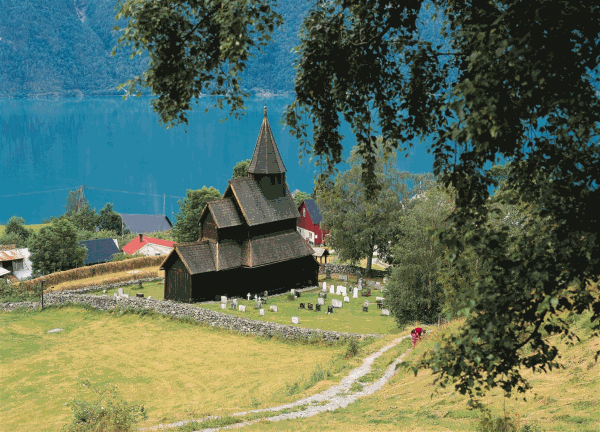
The tiny church, dating from the 12th century, is an example of traditional Scandinavian wooden architecture with many intricately carved Viking and Celtic patterns. Considering its age, it’s remarkably well preserved. From there, I caught the car ferry across Lustrafjord to Solvorn, a tiny seaside town that’s charming. Just steps from the ferry dock I found the family-run Walaker Hotel, which has been welcoming guests since 1640 when it was a simple guesthouse. Today, there are just 22 rooms housed in three buildings, with an art gallery occupying the fourth, a restored barn. I savored a glass of wine in the flower filled garden before heading to dinner and could not have imagined a more delightful spot to unwind. Reliving the magical landscapes I’d encountered during my week in Norway, I asked myself which was the best. It was impossible to choose now that I was out of the car! But I would never be out of Norway, at least in my mind.
[alert type=white]
The international dialing code for Norway is 47.
Where to Sleep:
Haholmen: To reach this little fishing village you take a replica Viking ship across the fjord and once there you can enjoy the natural beauty of the 13-acre island. Visit the small museum on adventurer Ragner Thorseth and sleep in one of the historic red and yellow cottages. Haholmen Island, 011-47-71-51-72-50, www.classicnorway.no
Juvet Landscape Hotel: A quick drive from Trollstigen National Tourist Route is this minimalist seven cabin retreat with wraparound picture windows (no televisions or phones) on the Valldola River. Meals are taken in a traditional wood-paneled main house. Gudbrandsjuvet, 011-47-950-32-010, www.juvet.com
Walaker: This hotel run by the Nitter family is the oldest hotel in Norway. The 22 rooms, many with four-poster beds and antique furniture, are spread among three buildings. There’s also a gourmet restaurant and an art gallery in a restored barn. N-6879 Solvorn, 011-47-57-68-20-80, www.walaker.com
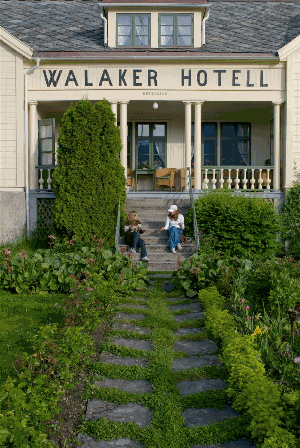
Where to Eat and Drink:
Smia: In the town of Kristiansund, this restaurant is housed in a traditional 18th century wood-beamed cottage and decorated with nautical equipment. It specializes in traditional dishes including a creamy fish soup and the award-winning bacalhau, a hearty cod stew. Fosnagaten 30 B, 011-47-716-71-170, www.smia.no
Turtagro Mountain Hotel: This is a great place to base yourself if you are traveling along the Sognefjellet National Tourist Route but even if you don’t stay, have lunch or dinner in the restaurant with mountain views. Try the house made sausages with potatoes and hearty brown bread. 6877 Fortun, 011-47-57-68-08-00, www.turtagro.no
Walaker: Before having dinner in the restaurant you can have a glass of Champagne or white wine in the garden. The menu features many seafood dishes including langoustines from the fjord as well as venison from the mountains and farmhouse cheeses. N-6879 Solvorn, 011-47-57-68-20-80, www.walaker.com
What to See and Do:
National Tourist Routes: There are 18 National Tourist Routes and several including Atlantic Road, Trollstigen or Troll’s Ladder and Sognefjellet are within driving distances of one another. The Trollstigen has a contemporary visitor’s center with a café and shop designed by Norwegian firm Reiulf Ramstad. www.visitnorway.us
Urnes Stave Church: This stave church, a UNESCO World Heritage Site, is the oldest such church in Norway. Dating from the 12th century the church is an example of Scandinavian wooden architecture with many carved Viking and Celtic motifs. After looking inside, stroll the peaceful cemetery and grounds. Solvorn, no phone or website.
[/alert]

